WOLA Gang Research Cited in New York Times
U.S. media frequently cite WOLA’s groundbreaking research on Central American gangs, including The New York Times which on Sunday, August 19, mentioned a recent WOLA report on Latino gangs in Washington, D.C., and quoted the research and outreach coordinator of the organization’s Central American Youth Gangs Project, Connie McGuire.
The report cited in the Times was released by WOLA in February 2007. Based on the results of a year-long transnational study on youth gangs in Central America, Mexico, and the Washington, D.C. area, and sponsored by the Instituto Tecnológico Autónomo de México, the study examined the relationship between gangs in Central America and gangs in the United States. McGuire conducted the Washington-area portion of the research by interviewing over 40 people, including former gang members, police and social service providers working with Latino youth at risk of joining gangs.
“One of the most important findings of the transnational study is that youth gangs are highly variable, meaning the magnitude and quality of the phenomenon are distinct in different locations,” said McGuire. “Even the so-called Central American gangs, Mara Salvatrucha and the 18th Street gang, are very different in San Salvador from gangs with the same name in Los Angeles or the Washington area.”
The study concluded that community-based, comprehensive approaches to the gangs, including prevention, rehabilitation and targeted enforcement efforts, are the most successful strategies for preventing violence.
“The former gang members that I talked with told me that most gang members want to leave the gang but are too afraid to admit it,” said McGuire, also a doctoral student in Anthropology at the University of California, Irvine. “When given a viable alternative to gang life, the vast majority choose to leave the gang.”
Washington’s Gang Intervention Partnership (GIP) is an example of a community-based response to gang violence. GIP brings together social service providers, police, school officials, probation officers and others to identify at-risk youth and intervene when necessary against violent behavior. Since GIP was formed in October 2003 in response to 13 Latino gang-related homicides that summer, the city of Washington has not had a single Latino gang-related homicide.
To read the executive summary of the report, “Transnational Youth Gangs in Central America, Mexico and the United States,” and detailed reports on gangs in each country, please click here .
To read WOLA’s report “Youth Gangs in Central America: Issues in Human Rights, Effective Policing, and Prevention,” released in November 2006, please click here.
To read the article in The New York Times, please click here .


